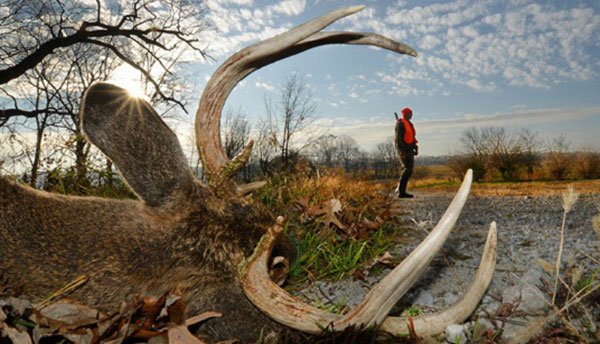By Louie Stout
 Stats Show Indiana Produces More Trophy Bucks
Stats Show Indiana Produces More Trophy Bucks
Does Indiana produce more trophy bucks than Michigan?
Sounds farfetched, I know. Michigan is supposed to be one of the country’s top deer hunting states and little ol’ Indiana, with its vast, fence-row to fence-row plowing seems hardly a deer hunting mecca.
But North Liberty deer scorer John Bogucki says Hoosierland kicks out more trophy bucks than our northern neighbor.
He should know. He is an official scorer for the Hoosier Record Buck Program, Commemorative Bucks of Michigan, Pope and Young, The Longhunter (muzzleloader record book) and Boone and Crockett.
In addition, Bogucki is the record keeper of the Hoosier record book and tracks all the stats of top deer harvested in the state over the years.
And while he doesn’t maintain the records for Michigan’s program, he is an official scorer and studies their record book annually. He knows what’s being killed north of the border.
“We (Hoosiers) are far surpassing the numbers of record book bucks killed than Michigan,” Bogucki said. “Hoosiers get 20 to 30 Boone and Crockett records (which has the toughest requirements) a year and Michigan gets maybe a half dozen.”
To qualify for any record book, a deer must meet minimum scores that are based on official measurements of the rack. For example, Indiana’s record book minimum is 140 for typical antlers and 160 for non-typical. Michigan is 100 for a bow and 125 for a gun.
The Pope and Young Book, for bow hunters, is 125 for typical and 140 for non-typical, The Longhunter is 130 for typical and 160 non-typical while Boone and Crockett requires 170 for a typical rack and 195 for a non-typical to make its book.
So why are Indiana hunters knocking down heavier antlered deer?
There are a number of possibilities. One that can’t be overlooked is that Indiana’s deer habitat is broken up into smaller tracts surrounded by farmland. When the harvest is on, deer are pushed out of the corn and into the woods where they are more confined and a little easier to target. Michigan has farmland, too, but it has larger areas of deer habitat. The animals have more plays to roam and hide.
However, Michigan has more hunters, too. Theoretically, more hunters in the field should result in more trophy bucks.
Bogucki has another theory. He believes Indiana’s one-buck rule has made a decided difference in how many quality bucks are taken each year. Michigan hunters are allowed two a year.
“When I compare the Indiana records before the one-buck rule and afterwards, there has been a remarkable upswing,” he said. “The number of entries climbed from logging about 200 record deer a year to over 400.”
However, he added, that number has dropped back into the 200s in recent years. He places the blame on Indiana’s liberal antlerless deer harvest.
Each St. Joseph, Elkhart and LaPorte County hunter can kill up to four antlerless deer a season. In Starke, Jasper, Pulaski and Porter County, its eight a year.
The DNR adjusts antlerless permits annually based on harvest rates, crop damage reports and deer-car collisions. It’s the method used by a lot of states for determining herd size; they fluctuate antlerless permit numbers based upon its estimated size of the herd.
Bogucki believes Indiana has overdone it.
“The deer population has been terribly diminished because of excessive doe permits,” he insisted. “You can’t create more bucks without having a good supply of does.”
He says it probably impacts deer license sales, too. A lot of fair weather hunters won’t buy licenses if not seeing deer.
“I hunt property near Potato Creek State Park,” said Bogucki. “That used to be a great area for deer hunting, but this year I saw one buck and very few does. Some other hunters say they didn’t see any deer at all this year.”
Another factor affecting Indiana’s herd was the EHD virus that ravaged northern Indiana’s herd a few years ago. It likely caused more fatalities than what Indiana biologists realize.
But how would they know? There isn’t a state district wildlife biologist living in this region and all of the guesswork comes out of Bloomington, some 200 miles to the south.
Southwest Michigan also battled EHD about the same time, but has been more proactive at monitoring disease issues with more biologists surveying smaller regions.
Hoosier biologists are simply spread too thin.




